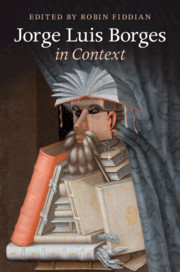Book contents
- Jorge Luis Borges in Context
- Jorge Luis Borges in Context
- Copyright page
- Contents
- Illustrations
- Contributors
- Acknowledgements
- Permissions
- Note on Primary Sources and Editions Used
- Chronology
- Note on Translations and Abbreviations
- Introduction Borges in Context, Context in Borges
- Part I Self, Family, and the Argentine Nation
- Chapter 1 Borges and the Question of Argentine Identity
- Chapter 2 Borges and the Banda Oriental
- Chapter 3 Borges in Person: Family, Love, and Sex
- Chapter 4 Jorge Luis Borges’s Fictions and the Two World Wars
- Chapter 5 Dictatorship and Writing (1976–1983)
- Chapter 6 The Public Author and Democracy (1984–1986)
- Chapter 7 Borges and Las Islas Malvinas
- Chapter 8 Borges and Sarmiento
- Chapter 9 Borges and the Gauchesque
- Chapter 10 1920s Buenos Aires
- Chapter 11 Borges and the Argentine Avant-Garde
- Chapter 12 The Argentine Writer and Tradition
- Chapter 13 Borges, Tangos, and Milongas
- Chapter 14 Borges and Bioy Casares
- Chapter 15 Borges and Popular Culture
- Chapter 16 Argentine Responses: César Aira and Ricardo Piglia
- Part II The Western Canon, the East, Contexts of Reception
- Further Reading
- Index
Chapter 14 - Borges and Bioy Casares
from Part I - Self, Family, and the Argentine Nation
Published online by Cambridge University Press: 16 January 2020
- Jorge Luis Borges in Context
- Jorge Luis Borges in Context
- Copyright page
- Contents
- Illustrations
- Contributors
- Acknowledgements
- Permissions
- Note on Primary Sources and Editions Used
- Chronology
- Note on Translations and Abbreviations
- Introduction Borges in Context, Context in Borges
- Part I Self, Family, and the Argentine Nation
- Chapter 1 Borges and the Question of Argentine Identity
- Chapter 2 Borges and the Banda Oriental
- Chapter 3 Borges in Person: Family, Love, and Sex
- Chapter 4 Jorge Luis Borges’s Fictions and the Two World Wars
- Chapter 5 Dictatorship and Writing (1976–1983)
- Chapter 6 The Public Author and Democracy (1984–1986)
- Chapter 7 Borges and Las Islas Malvinas
- Chapter 8 Borges and Sarmiento
- Chapter 9 Borges and the Gauchesque
- Chapter 10 1920s Buenos Aires
- Chapter 11 Borges and the Argentine Avant-Garde
- Chapter 12 The Argentine Writer and Tradition
- Chapter 13 Borges, Tangos, and Milongas
- Chapter 14 Borges and Bioy Casares
- Chapter 15 Borges and Popular Culture
- Chapter 16 Argentine Responses: César Aira and Ricardo Piglia
- Part II The Western Canon, the East, Contexts of Reception
- Further Reading
- Index
Summary
Borges’s writing partnership with Bioy Casares was long-lasting and fruitful, producing a unique narrative voice and several pseudo–authors. Two of these are Bustos Domecq and Isidro Parodi –specialists in crime detection and detective fiction. Bioy and Borges collaborated as editors and compilers – of anthologies, prologues, glosses, and translations. Their attacks on nationalist and populist politics were especially virulent in the period 1942-1947, with General Perón the main target. ’La fuerza del monstruo’ (1947) is a powerful condemnation of the abuse of power and could not be published until his removal from power in 1955. A key feature of ’La fiesta...’ is its linguistic texture, constructing a carnival atmosphere.
- Type
- Chapter
- Information
- Jorge Luis Borges in Context , pp. 115 - 122Publisher: Cambridge University PressPrint publication year: 2020

